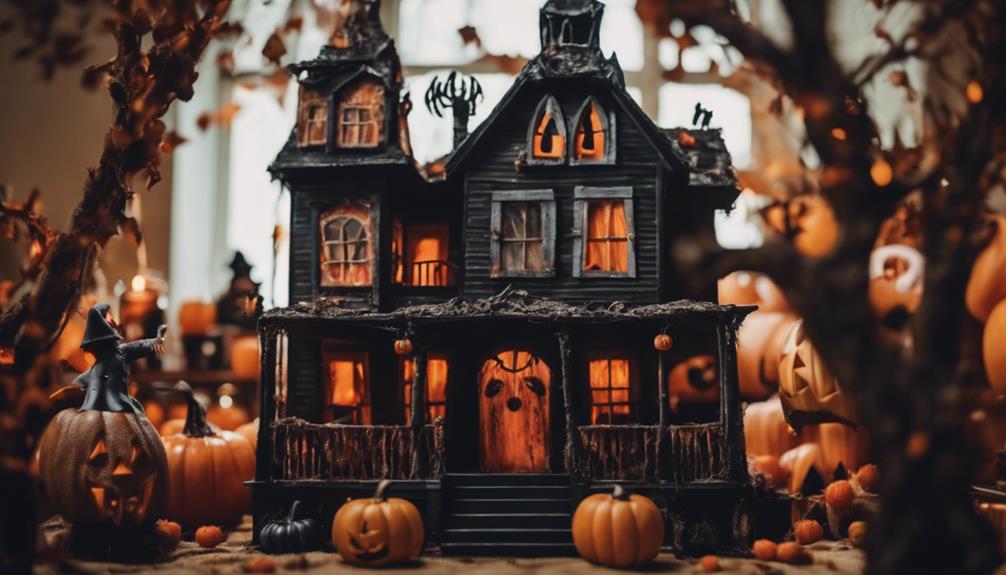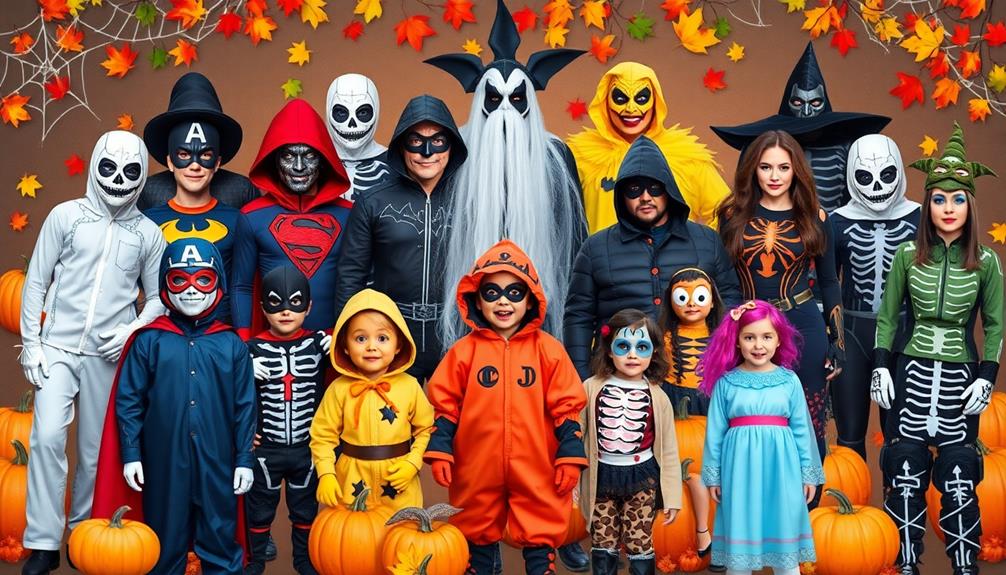Trick-or-treating in the U.S. has evolved from ancient European customs involving costumes and small treats into a vibrant modern celebration. Over time, communities grew more diverse, shifting from close-knit neighborhoods to bustling urban areas. Today, technology enhances costumes with lights and interactivity, while safety regulations help protect participants. As new trends and innovations emerge, the tradition continues to adapt. To explore how these changes shape Halloween festivities, keep going to uncover more.
Key Takeaways
- Originated from European customs involving costumes, prayers, and food exchanges, evolving into community treat-giving traditions.
- Shift from simple homemade candies to commercial treats, with costume styles changing from spooky to playful influenced by pop culture.
- Urbanization and community diversity led to the decline of traditional door-to-door trick-or-treating, replaced by organized events and multicultural celebrations.
- Modern innovations include LED costumes, digital planning tools, augmented reality experiences, and eco-friendly treats enhancing celebrations.
- Safety regulations such as curfews, costume restrictions, and traffic controls have evolved to ensure children’s safety during festivities.
Origins and Early Traditions of Trick-or-Treating

The origins of trick-or-treating can be traced back to ancient European customs, where people would dress in costumes and go door-to-door offering prayers or songs in exchange for food or money. Over time, these traditions evolved into communities exchanging treats for small acts. When it came to candy preferences, early treats were simple and homemade, but as commercial candies became popular, kids’ choices expanded. Costume trends also shifted from spooky or religious attire to more playful and creative outfits, influenced by popular culture. You might notice that today’s costumes reflect current trends, but the core idea of disguising oneself and visiting neighbors remains the same. These early customs laid the foundation for the modern, candy-filled celebration we now enjoy every October 31st, with candy varieties playing a significant role in shaping the tradition.
The Impact of Cultural Shifts and Community Changes
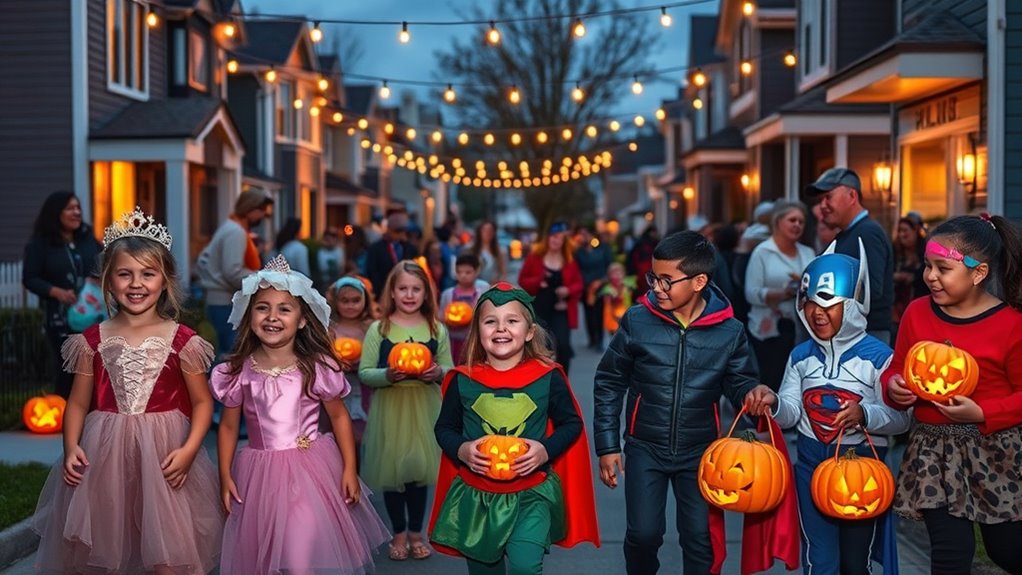
As American society has evolved, so too has the way communities participate in trick-or-treating, reflecting broader cultural shifts. Neighborhood dynamics have shifted from small, close-knit groups to more diverse and transient communities. This cultural diversity influences how people celebrate, with some areas embracing multicultural costumes and inclusive events, while others see a decline in traditional door-to-door activities. These changes often stem from increased mobility, urbanization, and changing social norms. You might notice fewer traditional neighborhood gatherings and more organized community events or alternative festivities. Despite these shifts, the core spirit of Halloween remains, adapting to reflect the evolving fabric of American society. Additionally, the rise of animated movies that touch hearts and the influence of various cultural elements contribute to how Halloween is celebrated today. Your experience of trick-or-treating now often mirrors these broader cultural and community transformations.
Technological Advances and Modern Celebrations
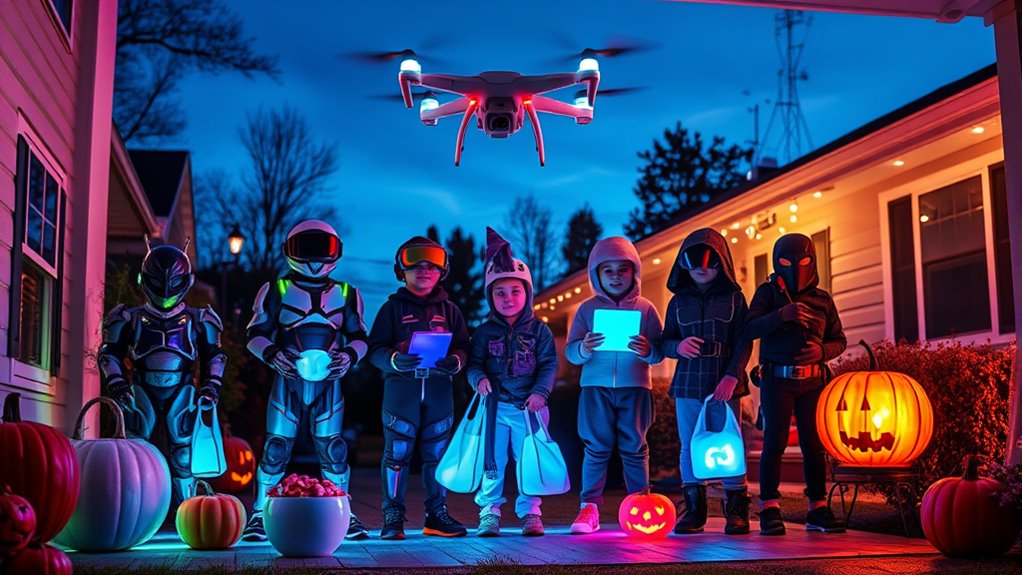
Technological advances have profoundly reshaped how people celebrate Halloween, especially in the domain of trick-or-treating. You’ll notice that costume trends now often include LED lights, animated features, and smart fabrics, making costumes more interactive and eye-catching. Candy innovations have also emerged, with manufacturers introducing new flavors, healthier options, and clever packaging that appeals to modern tastes. Additionally, digital tools like mobile apps and online communities help you plan routes, find nearby events, and even share your costume creations. Some communities use augmented reality to enhance the experience, blending technology with tradition. These modern touches make trick-or-treating more engaging and personalized, ensuring Halloween remains exciting for new generations while embracing innovative trends. As sustainable living practices continue to grow, many communities are also exploring eco-friendly alternatives for costumes and treats, promoting greener celebrations.
Safety Concerns and Regulatory Measures
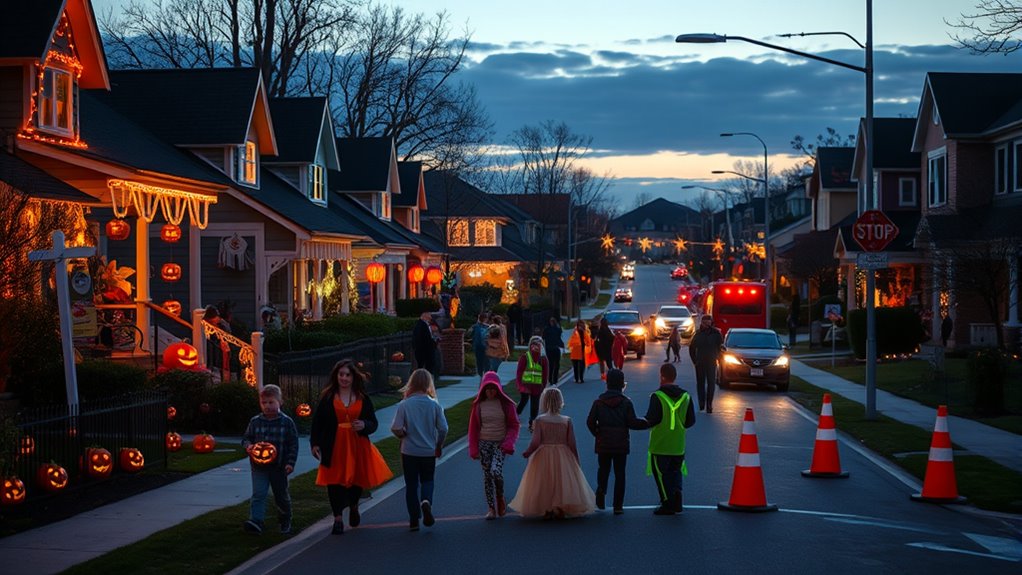
Safety concerns have become a central focus of modern trick-or-treating, prompting communities to implement various regulatory measures. You’ll notice neighborhood regulations aimed at enhancing child safety, such as designated trick-or-treat hours, curfews, and restrictions on certain costumes. These rules help guarantee a safer experience for everyone. To illustrate, consider the table below:
| Regulation Type | Purpose |
|---|---|
| Curfews | Prevent late-night incidents |
| Costume Restrictions | Avoid masks that impair vision |
| Traffic Control Measures | Reduce accidents during peak hours |
Additionally, some communities are adopting diverse designs in safety gear and costumes to further improve visibility and reduce hazards during festivities.
The Future of Trick-or-Treating in a Changing World
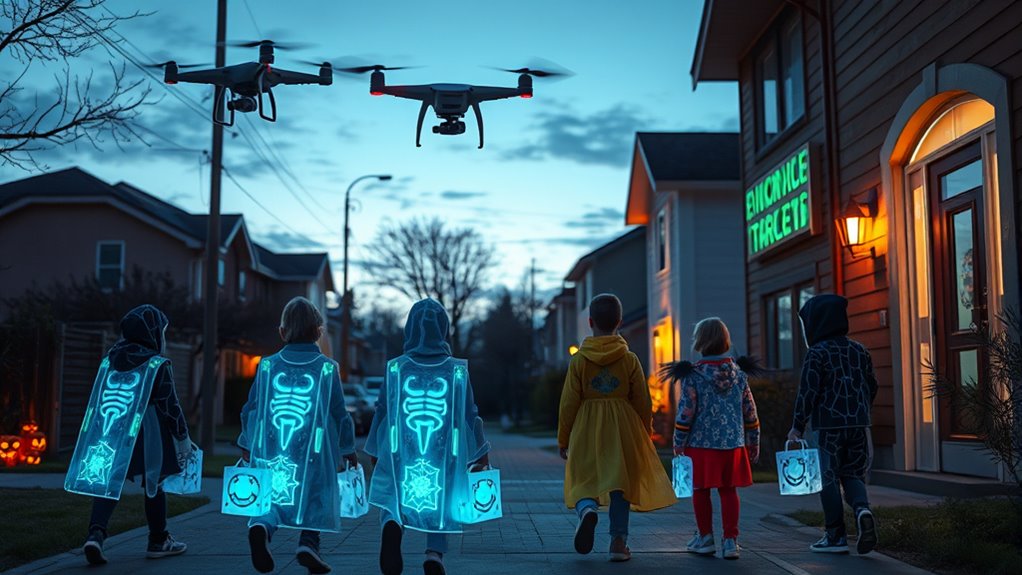
The future of trick-or-treating will likely be shaped by evolving technology, changing social norms, and ongoing safety considerations. As cities adapt through urban modifications, you’ll see more designated trick-or-treat zones or digital experiences that blend tradition with innovation. Global influences will also play a role, introducing new themes and customs that diversify celebrations across communities. Virtual costume parties and augmented reality adventures may supplement traditional door-to-door visits, especially in densely populated areas. Safety remains a priority, prompting new guidelines for neighborhood gatherings and the use of contactless delivery options. Overall, you’ll notice a dynamic mix of local adaptation and international trends, ensuring trick-or-treating evolves into a more inclusive, innovative, and safer experience in a changing world. Additionally, incorporating active listening and empathy principles can help communities foster more connected and understanding celebrations.
Frequently Asked Questions
How Did Trick-Or-Treating Originate in Europe Before Spreading to America?
You might find that trick-or-treating has European origins, especially connected to Celtic festivals like Samhain. During these festivals, people dressed in costumes to ward off spirits and left offerings for them. Over time, these customs evolved, and in medieval Britain and Ireland, children went door-to-door for food or money, similar to modern trick-or-treating. When settlers arrived in America, they brought these traditions with them, adapting them to local customs.
What Role Did Media Influence Play in Shaping Modern Trick-Or-Treating Practices?
Did you know that nearly 80% of kids say media portrayal influences their Halloween expectations? Media and advertising influence modern trick-or-treating by shaping costumes, decorations, and activities. TV shows, movies, and ads project spooky, fun themes that kids want to emulate. This creates a cycle where media portrayal directly impacts the way you celebrate, making Halloween more exciting and commercialized than ever before.
How Do Different Regions in the U.S. Vary in Trick-Or-Treating Customs?
You’ll notice that regional customs influence trick-or-treating across the U.S., with some areas favoring door-to-door visits while others host community parties. Costume variations also differ; in the South, you might see more traditional or humorous outfits, whereas the Northeast often features spooky themes. These local traditions shape your experience, making each region’s trick-or-treating unique, lively, and full of cultural flavor.
Are There Alternative or Emerging Traditions Replacing Traditional Trick-Or-Treating?
Think of Halloween as a garden where new blooms appear alongside traditional flowers. You might find trick-or-treat alternatives like Halloween parties, haunted house visits, or community festivals growing in popularity. Emerging Halloween traditions, such as pumpkin carving contests or themed scavenger hunts, are replacing or supplementing classic trick-or-treating. You embrace these new customs, creating fresh ways to celebrate, while still honoring the spirit of fun and community that Halloween embodies.
How Do Community Organizations Contribute to Safe Trick-Or-Treating Events?
Community organizations play a crucial role in guaranteeing safe trick-or-treating events by prioritizing community safety through well-planned activities and security measures. Volunteer involvement is essential as it helps monitor neighborhoods, manage crowds, and provide assistance when needed. Your participation in these initiatives, whether as a volunteer or supporter, enhances safety, creates a festive atmosphere, and ensures everyone, especially children, enjoys a fun and secure Halloween experience.
Conclusion
As you’ve seen, trick-or-treating has evolved like a lively mosaic, blending tradition with modern twists. Despite safety concerns and changing times, its spirit continues to shine bright, reminding you that community and creativity make every Halloween unforgettable. Embrace these changes, and remember, no matter how much things shift, the magic of dressing up and sharing treats is a timeless treasure that keeps the Halloween spirit alive in your heart.




